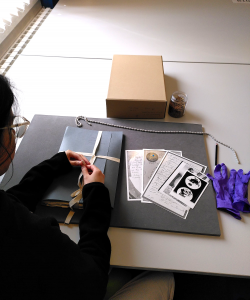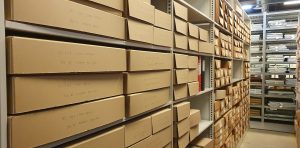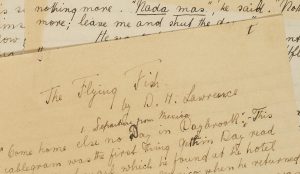
May 16, 2024, by Sarah Colborne
Time with Lawrence – a student from Malaysia campus on her archive placement
This is a guest post by Yunyu, a student from the University of Nottingham’s Malaysia campus who recently completed a volunteer placement at Manuscripts and Special Collections working on the uncatalogued papers of John Worthen, a world renowned D.H. Lawrence expert and former member of staff at UoN. Yunyu’s placement concentrated on Worthen’s work as editor for the Cambridge University Press edition of The Works of D.H. Lawrence, and included elements of detective work to identify which of Lawrence’s literary works his editorial notes, correspondence and photocopies relate to.
Welcomed to the expansive and cool building of King’s Meadow Campus, which was formerly a regional television station, I was immediately struck by its impressive scale and carefully preserved ambiance. King’s Meadow Campus engaged my colleagues and me in discussions on the English currency systems like shillings, pence, and the transition to decimalisation that sparked laughter and good-natured jokes, bridging the age and generational gaps among us.
Throughout my 3-month placement as an archives’ assistant with my lovely supervisors Amy Bowler and Sarah Colborne, I managed to gain first-hand experience assisting with the work of Manuscripts and Special Collection (MSC). My role involved collaborating with MSC to work with D H Lawrence’s many celebrated publications, personal drafts, writings, and periodicals dating from the late 1800s. Cataloguing a wealth of dated yet fashionable information had never seemed like a viable full-time job to me, particularly as someone interested in heritage and cultural intersections. If you are, like me, a student who has popped into Lakeside Arts to see our many exhibitions throughout the year, such administrative initiatives have inextricably formed the basis of the many meticulous, rare and plentiful works available to you for free.
Just as how the legend of Robin Hood keeps Nottinghamshire’s spirits alive, this Eastwood-born writer prodigy has lent his name to household names which scripts I examined including Netflix’s Lady Chatterley’s Lover. Born in Eastwood, just a bus ride away from the University of Nottingham, his muse includes Jessie Chambers (not to be confused with Jesse Boot!) whose name is mentioned quite frequently in the manuscripts I examined. For him writing professionally for the first time, under the tertiary tutelage of his alma mater University College Nottingham (now University of Nottingham), it still is of great wonder owing to his persistence for he handwrote many of his exceptional manuscripts while being a student at the university!
His calligraphic handwriting, so deftly and thoughtfully invested into every syllable, every letter, every noun, represents works of art while maintaining his aesthetically pleasing cursive writing styles that I truly adore. Not to mention, D H Lawrence’s literary work is an inspiration to many aspiring creatives and write-smiths.
His sophisticated and mature writing style, driven by a passion so uniquely his own, has been extensively endorsed and supported by prestigious institutions like the University of Texas at Austin and University of California as well as the University of Nottingham.
The preservation of D H Lawrence’s literary manuscripts in their different editorial forms, some of which are archaic by today’s standards has allowed me to find technical terms that I can include in my linguistic arsenal. Literary publications are polished versions of literary manuscripts. The rawest and purest forms of manuscripts are holograph manuscripts which can be susceptible to ‘foxing’ or the yellowing of papers, hence the requirement of gloves to handle them. I learned and implemented proper handling techniques using acid-free paper, brass paperclips, and soft 2B pencil, ensuring meticulous care and efficient organization of these materials. Galley proofs and undistributed proof copies are stages between the holograph manuscript and the final published work. Both are adorned with numerous handwritten editing notes in the days before Word or Google Docs editing functions came in handy.
I also managed to refine my practical administrative skills, particularly within Excel, and focused on developing expertise in organisational functions like ‘Sort and List’, which proved instrumental in streamlining data management.
More information about the D H Lawrence collections held by Manuscripts and Special Collections can be viewed here: https://www.nottingham.ac.uk/manuscriptsandspecialcollections/collectionsindepth/lawrence/introduction.aspx
No comments yet, fill out a comment to be the first




Leave a Reply